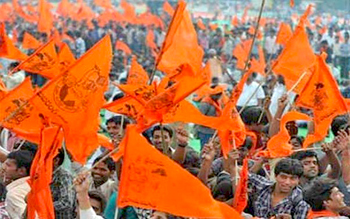Udupi, Aug 20: Vishva Hindu Parishad and Bajrang Dal have completely disowned the cow vigilantes who lynched a BJP worker to death in Udupi district and claimed that they never encouraged violence.
 29-year-old Pravneen Poojary, a local BJP leader died at a hospital on August 17 within an hour after he was attacked by a group of group of miscreants who apparently owed allegiance to different Hindutva groups. The assailants claimed that he was transporting cows to a slaughterhouse.
29-year-old Pravneen Poojary, a local BJP leader died at a hospital on August 17 within an hour after he was attacked by a group of group of miscreants who apparently owed allegiance to different Hindutva groups. The assailants claimed that he was transporting cows to a slaughterhouse.
Asked about the incident, Gopalji, South India organizing secretary of VHP, said that members of his organization don't resort to killing people. “The VHP and Bajrang Dal are in no way connected with the lynching incident in Udupi,” he said.
Jagadeesh Shenava, working president of the VHP in Mangaluru taluk, did not condemn the incident. “This should serve as a lesson to Hindus who sell cows," he said and added that he does not know the full details of what happened and why it happened.
Sunil VR, Bajrang Dal convener for Mangaluru, Udupi and Puttur, also said the attackers were not from his organization. "Our boys don't murder. We don't support such acts; we involve the law-and-order machinery when we come to know of such acts."
Police have arrested around 25 persons including a few senior members of HJV in connection with the incident. However, local residents claim that activists of VHP and Bajrang Dal also were part of the group of assailants.
Also Read:
Some Sangh Parivar activists indulging in illegal cattle trade: Former BJP MLA
Those Hinduvta activists too should meet similar fate: Slain BJP worker's mother
'Cows rescued' by vigilantes in coastal Karnataka end up in slaughterhouses'
Udupi: Slain BJP worker's family accuses Hindutva activists of backstabbing




Comments
Where are you Chaddi Naren, you looks quite well, once your Criminal looter team did this barbaric murder, public now understand your Goons the main culprits to Transport the God of Nation COWS to the Slaughter houses any way Master Naren you still hiding in Snake Land, you Lucky, the day will come to you all Criminals then you learn.
Jai Hoo Hindustan
Jai Bharath Mathaki.
\Our boys don't murder. We don't support such acts
missing shobakka's press conference.
SHOBKKA PLEASE COME OUT SAY SOMETHING............AWAITING YOUR STATEMENT.............YOUR PEOPLE DIED............
DEAR GOVT OF KARNATAKA, ONE MORE INCIDENT ADDED TO BAN BD, RSS, VHP , SRS. NOW ITS TIME TO BAN THESE SAFFRON TERRORIST GROU
BAN RSS, BD, VHP SRS....
It took that much time. During this period they found that there were witnesses and they could not blame others.
This terrorist gruops chelas gopal;sheba, sunil are really a crackpot, winte's people's are inform all attackers are from baring terrorist outfit.
State Govt must take strict action against these tree n send them at least one year to Bellary jail. One away from their family then only they will understand the value of Father, Mother and family member.
Add new comment